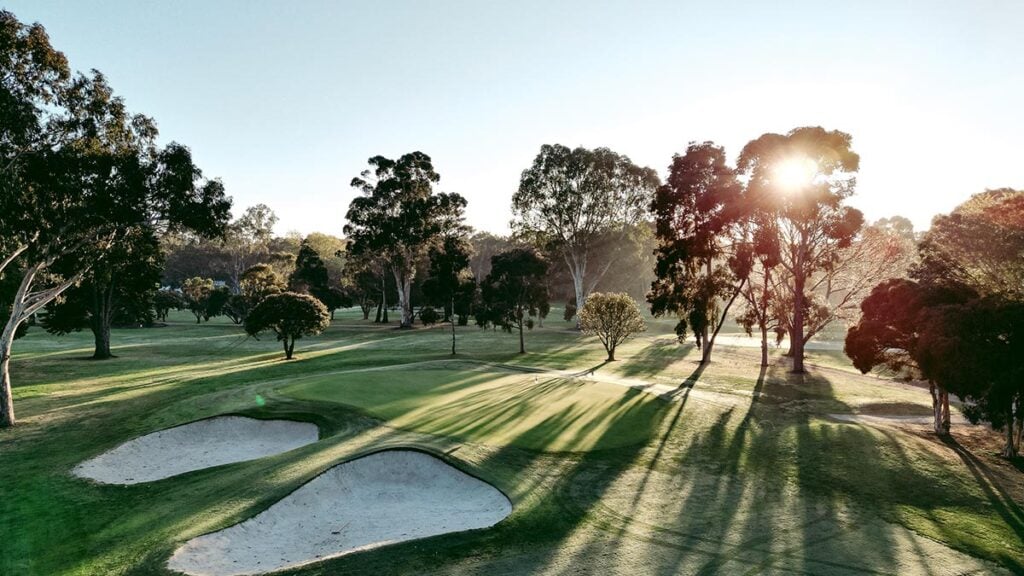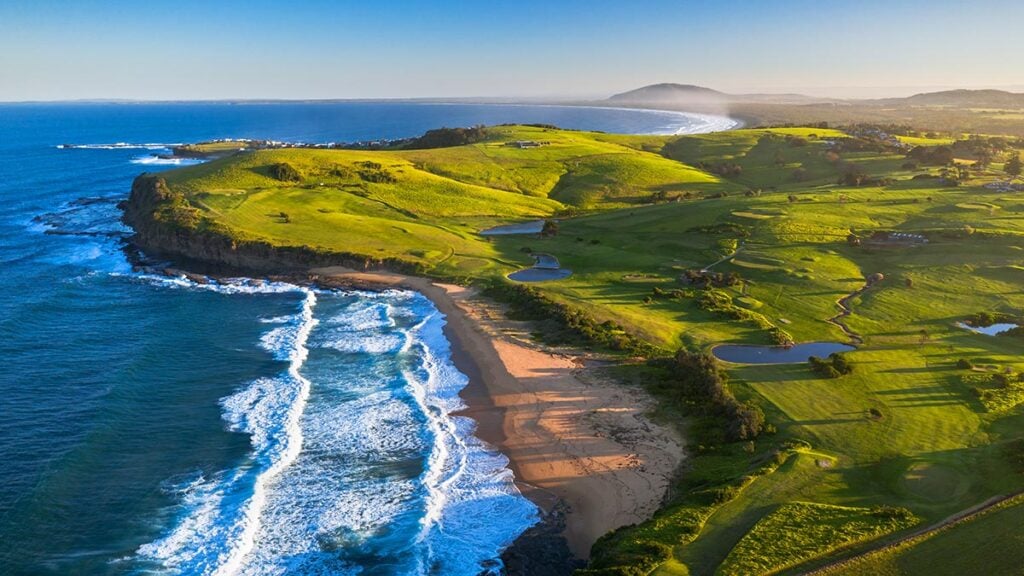The five biennial Golf Digest World’s 100 Greatest Courses rankings – the first was published in 2014 – reveal several consistencies.
Royal County Down, the top-ranked course for 2022-2023, for instance, has also been the No.1-ranked international course in each previous poll (the first rankings included US courses, while the last three have been only for courses outside the US).
RELATED: Check out the full list of Golf Digest’s new World 100 Greatest Courses
The 350 panellists who live beyond the US borders bring a truly international perspective to the list, as courses from 25 different countries made this year’s rankings. Designs from the UK and Ireland, where golf was born, feature prominently – Scotland leads the way with 17, followed by 13 from England – but Canada (12), Australia (10), New Zealand (4) and Japan (4) also made strong showings. China, Mexico, South Africa and South Korea all charted three.
The panellists are also quick to recognise excellence. In the past it’s taken very little time for courses like Tara Iti (this year’s No.2 course), Cabot Cliffs (No.10) and Cape Wickham (No.12) to surge to the top of the rankings. Each opened in 2015 and have been fixtures since. Two new courses that opened in 2021 that we expect to see in the rankings soon – Gil Hanse and Jim Wagner’s New course at Les Bordes in France, and Tom Doak’s St Patrick’s Links at Rosapenna in Ireland – scored highly but didn’t receive enough panellist play to qualify for this year’s list, undoubtedly due to the impact of COVID and travel restrictions in 2020 and 2021.
Twelve courses made this year’s list that weren’t featured in the previous ranking. Some like St Enodoc in south-western England and The Durban Country Club return after hiatus, while numerous others make their debut, including a trio from Europe. Other courses, meanwhile, fell off the World 100, perhaps temporarily, perhaps not, including South Korea’s South Cape Owner’s Club, Ellerston in Australia, Doonbeg and Cabo del Sol’s Ocean course. Such is the revolving nature of golf course rankings, where estimations and assessments move, change, and rarely stand still.
(Note: brackets indicate course’s previous ranking. The previous ranking indicated on this list is the course’s ranking on our previous World 100 list.)
1 [1] ROYAL COUNTY DOWN G.C. (CHAMPIONSHIP)
Newcastle, Northern Ireland
Old Tom Morris (1889), Donald Steel (remodeled, 1998)
7,186 yards, par 71
Score: 8.659

On a clear spring day, with Dundrum Bay to the east, the Mountains of Mourne to the south and gorse-covered dunes in golden bloom, there is no lovelier place in golf. The design is attributed to Old Tom Morris but was refined by half a dozen architects in the past 120 years, most recently by Donald Steel. Though the greens are surprisingly flat, as if to compensate for the rugged terrain and numerous blind shots, bunkers are a definite highlight, most with arched eyebrows of dense marram grasses and impenetrable clumps of heather.
2 [2] TARA ITI G.C.
Mangawhai, New Zealand
Tom Doak (2015)
6,840 yards, par 71
Score: 8.600

Built by American designer Tom Doak from what had been a pine-covered Sahara along the eastern coast of New Zealand’s North Island, it’s far more links-like than the country’s other coastal courses, most of which are on rock. Doak and design associate Brian Slawnik spent more than two years gently resculpting the sandy soil into hummocks, punchbowls and sand dunes that look like they were formed by wind and vegetated by nature. There’s lots of sand but no bunkers. Golfers may ground the club anywhere. With holes inspired by Cypress Point, Royal Dornoch and Royal St George’s, and views everywhere of the Hauraki Gulf, this may be New Zealand’s answer to Pebble Beach’s Carmel Bay. The greatest meeting of land and sea is clearly up for debate.
3 [4] ROYAL DORNOCH G.C. (CHAMPIONSHIP)
Scotland
Old Tom Morris (1892), George Duncan (1947), Donald Steel (1993), Tom Mackenzie (2013)
6,704 yards, par 70
Score: 8.553
Herbert Warren Wind called it the most natural course in the world. Tom Watson called it the most fun he’d had playing golf. Donald Ross called it his home, having been born in the village and learned the game on the links. Tucked in an arc of dunes along the North Sea shoreline, Dornoch’s greens, some by Old Tom Morris, others by John Sutherland or 1920 Open champion George Duncan, sit mostly on plateaus and don’t really favor bounce-and-run golf. That’s the challenge: hitting those greens in a Dornoch wind.
4 [5] ROYAL MELBOURNE G.C. (WEST)
Black Rock, Australia
Alister MacKenzie, Alex Russell (1931), Tom Doak (2015-’16)
6,645 yards, par 72
Score: 8.551
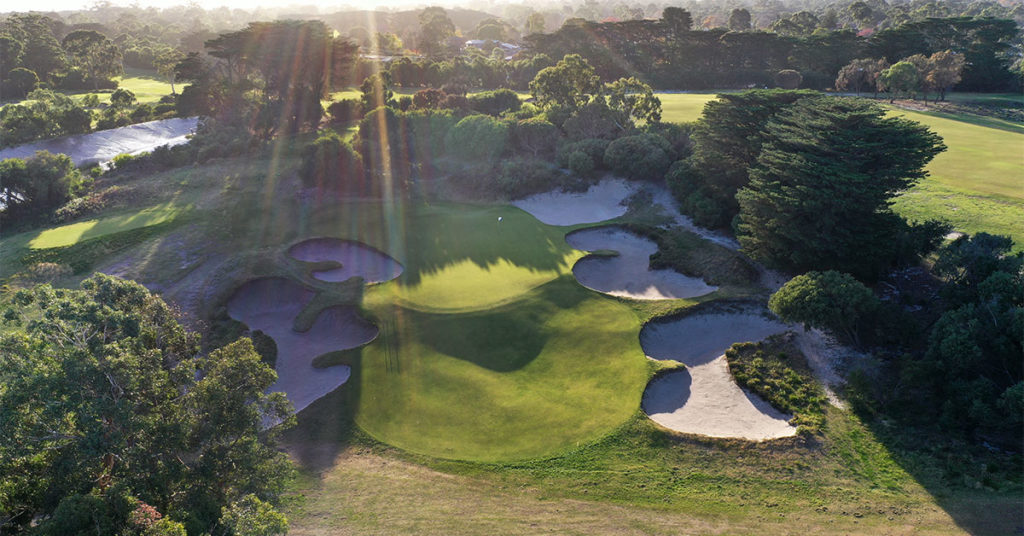
Alister MacKenzie’s 1926 routing fits snuggly into the contours of the rolling Sandbelt land. His greens are miniature versions of the surrounding topography. His crisp bunkering, with vertical edges, a foot or taller, chew into fairways and putting surfaces. Most holes are doglegs, so distance means nothing and angle into the pin is everything. For championships, holes eight and nine and 13 through 16 are skipped in favour of six from the East course, which is ranked 19th. That “Composite course” was once ranked among the best in the world by several publications.
5. [7] MORFONTAINE G.C.
France
Tom Simpson (1927), Kyle Phillips (2004)
6,584 yards, par 70
Score: 8.464
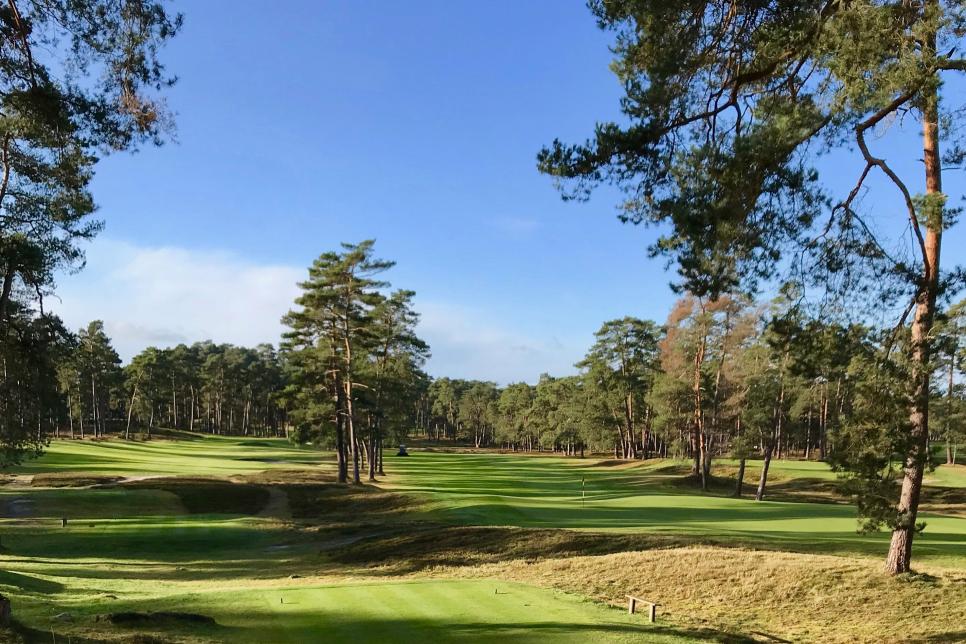
A timeless 1927 design north of Paris by British architect Tom Simpson, Morfontaine looks suspiciously like a heathland course around London, with windswept Scotch pines and clumps of heather atop a base of sand. But it’s tighter than Sunningdale or St George’s Hill, and the forest surrounding holes is far denser. Thirteen years ago, American architect Kyle Phillips updated the layout in 2004, adding a new 12th green to extend the par 5 by 60 yards. It fits in perfectly.
6 [13] HIRONO G.C.
Hyogo, Japan
C.H. Alison (1932), Martin Ebert (2018-’19)
7,169 yards, par 72
Score: 8.461
This is undoubtedly the finest design of globetrotting C.H. Alison, longtime partner of H.S. Colt. He laid out Hirono in the early 1930s in a hilly pine forest slashed by gulleys, clearing wide corridors and positioning greens on the crests of ridges. What makes Hirono special was Alison’s spectacular bunkering, which ranged from diagonal cross bunkers, fearsome carry bunkers and strings of ragged-edged ones. Soon after completion, writers were calling Hirono the Pine Valley of Japan. The restorative work by Ebert and Mackenzie has sharpened the teeth of Alison’s bunkering and restored the lost tees of the par-3 13th, making the hole play once again at an angle to the fronting lake rather than directly across it.
7 [3] MUIRFIELD
Gullane, Scotland
Old Tom Morris (1891), H.S. Colt (1925), Martin Hawtree (2011)
7,245 yards, par 71
Score: 8.440
Muirfield is universally admired as a low-key, straightforward links with fairways seemingly containing a million traffic bumps. Except for a blind tee shot on the 11th, every shot is visible and well-defined. Greens are the correct size to fit the expected iron of approach. The routing changes direction on every hole to pose different wind conditions. The front runs clockwise, the back counterclockwise, but history mistakenly credits Old Tom Morris with Muirfield’s returning nines. That was the result of H.S. Colt’s 1925 redesign.
8 [8] ROYAL PORTRUSH G.C. (DUNLUCE)
Northern Ireland
Tom Gilroy (9, 1888), Old Tom Morris (9, 1889), H.S. Colt (1933), Martin Ebert (2015)
7,317 yards, par 72
Score: 8.4375

Portrush is still the only Irish course to host The Open. The Old Tom Morris design, reworked by H.S. Colt in the 1930s, was the Open site back in 1951, and was again in 2019. In preparation, architect Martin Ebert added new seventh and eighth holes, fashioned from land on the club’s Valley course, to replace its weak 17th and 18th. That means the notorious Calamity Hole, an uphill 210-yard par 3, will now be the 16th instead of the 14th, and the old dogleg-right par-4 16th will now be the closing hole, with a new back tee. Ebert retained Colt’s greens, considered one of the best set of putting surfaces in the world.
9 [6] THE OLD COURSE AT ST ANDREWS
Fife, Scotland
Allan Robertson (1848), Old Tom Morris (1865-’85), Martin Hawtree (2013-’14)
7,279 yards, par 72
Score: 8.394

The Old Course at St Andrews is ground zero for all golf architecture. Every course designed since has either been in response to one or more of its features, or in reaction against it. Architects either favour the Old Course’s blind shots or detest them, either embrace St. Andrews’ enormous greens or consider them a waste of turf. Latest polarising topic: Martin Hawtree’s design changes in advance of the 2015 Open Championship, which many considered blasphemy beforehand. After Zach Johnson’s dramatic overtime victory, few mentioned the alterations. We’ll see how the latest (minor) alterations play out when the historic links hosts the 150th Open Championship in July.
10 [11] CABOT CLIFFS
Inverness, Nova Scotia, Canada
Bill Coore, Ben Crenshaw (2015)
6,765 yards, par 72
Score: 8.387
Another sensational Bill Coore and Ben Crenshaw design, Cabot Cliffs overflows with variety with its southernmost holes in Lahinch-like sand dunes, its northernmost atop Pebble Beach-type ocean cliffs and bits of pine-lined Scottish highlands in between. The course has six par 5s, including three in the space of four holes, and six par 3s, plus an additional one-shot bye-hole aside the fourth. Sporting the same fescue turf mix as nearby sister course Cabot Links (ranked 39th), some tee shots seem to roll forever, but so do errant shots that miss greens. The cliff-edged par-3 16th is quickly becoming one of the game’s most photographed holes.
11 [12] KINGSTON HEATH G.C.
Heatherton, Australia
Des Soutar, Mick Morcom (1925), Mike Clayton (2002)
7,102 yards, par 72
Score: 8.289

Considered an Alister MacKenzie design, but in fact Australian golf professional Des Soutar designed the course in 1925. MacKenzie made a brief visit the next year and suggested the bunkering, which was constructed by greenkeeper Mick Morcom before he built Royal Melbourne’s two courses. The bunkers are long, sinewy, shaggy, gnarly, windswept and, of course, strategically placed. Some say MacKenzie’s tee-to-green stretch of bunkers on the par-3 15th set the standard for all Sandbelt layouts.
12 [21] CAPE WICKHAM LINKS
King Island, Australia
Mike DeVries, Darius Oliver (2015)
6,725 yards, par 72
Score: 8.216
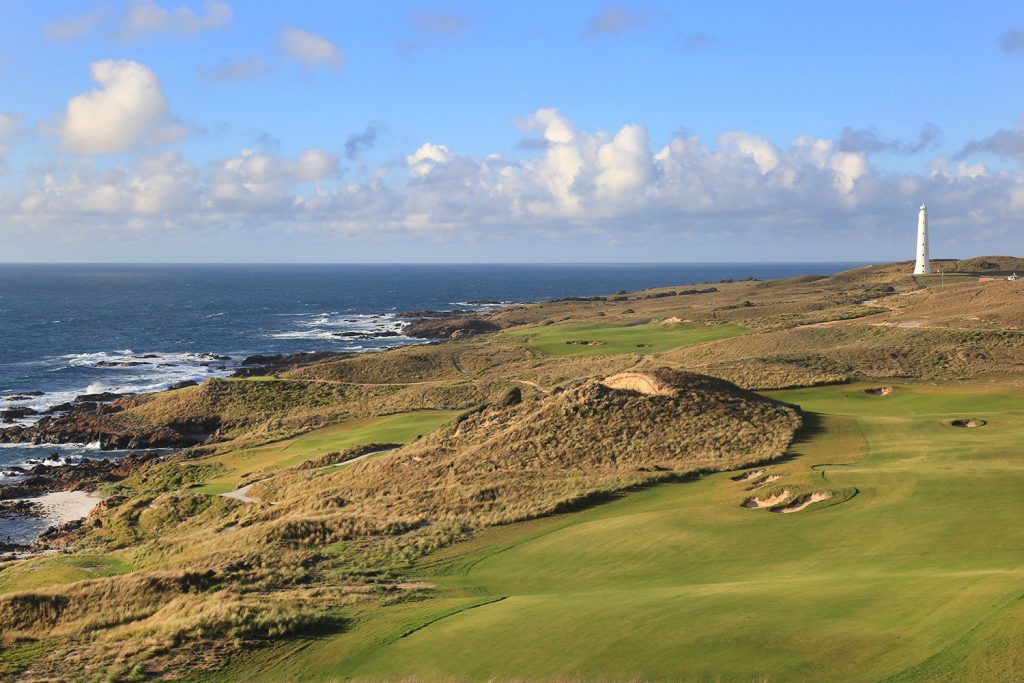
American Mike DeVries and Australian golf writer-turned course architect Darius Oliver collaborated on a breathtaking site along Bass Strait, a notorious stretch of Australian seacoast that once shipwrecked many voyages. The routing on this glorious collection of holes is heart-pounding, starting along rocks and crashing surf, moving inland but not out of the wind, returning to ocean edge at the downhill 10th, pitch-shot 11th and driveable par-4 12th. It then wanders into dunes before a crescendo closing hole curving along Victoria Cove beach, which is in play at low tides.
13 [10] TRUMP TURNBERRY (AILSA)
Scotland
P.M. Ross (1951), Martin Ebert (2015)
7,489 yards, par 71
Score: 8.189
A legendary links ravaged by WWII, architect Philip Mackenzie Ross re-established it to its present quality, tearing away concrete landing strips to create a dramatic back nine and building a set of varied greens, some receptive, other not so much. After Donald Trump purchased the course, Martin Ebert of the firm of Mackenzie & Ebert made notable changes, creating new par 3s at holes six and 11, converting the old par-4 ninth into an ocean-edge par 3, and turning the fifth, 10th and 14th into par 5s and the 17th into a long par 4. New tees on 18 eliminate its old dogleg tee shot. To complete the new look, Ebert replaced revetted bunkers with ragged-edged ones.
14 [33] NEW SOUTH WALES G.C.
Le Perouse, Australia
Des Soutar, Carnegie Clark, Alister MacKenzie (1928), Eric Apperly (1936), Greg Norman (2010), Tom Doak (2018)
6,829 yards, par 72
Score: 8.162

On the dramatic rugged seacoast of Botany Bay in Sydney, on the spot where Captain Cook first stepped onto Australia in 1770, La Perouse is renowned for its ocean views and high winds. On his brief but productive 1926 trip, Alister MacKenzie prepared a routing for the course, but it was radically altered during a 1936 remodeling by Eric Apperly and by neglect during WWII. A succession of post-war architects has slowly re-established the integrity of the design, most recently Tom Doak.
15 [15] SUNNINGDALE G.C. (OLD)
England
Willie Park Jr. (1901), H.S. Colt 1922), Donald Steel (1986)
6,627 yards, par 70
Score: 8.149
A Willie Park Jnr design that dates from 1901, it’s perhaps the most advanced of its day. Chopped from a pine forest but routed like a links, with the ninth at the far end of the property, it plays like a links, too, for there’s a sand base beneath the turf. The Old has big greens, as Park put a premium on approach putting, and artful bunkers, with both angled cross-bunkers and necklaces of sand hampering direct routes to some greens. To American visitors, the look of Sunningdale brings to mind Pine Valley or Pinehurst.


